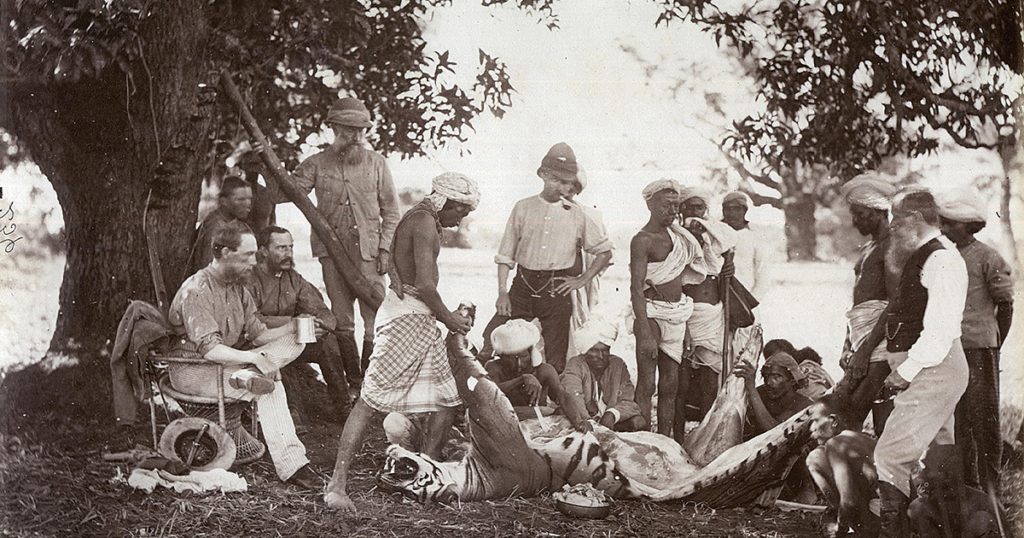
The British in India: A Social History of the Raj by David Gilmour; Farrar, Straus and Giroux, 640 pp., $35
Among his many vanities, Lord Louis Mountbatten, the last viceroy of India, imagined that he had forged an entirely new relationship with Indians by decreeing upon his arrival in 1947 that they would henceforth make up half the guests at any viceregal soirée. One doubts that his forebear David Ochterlony, the early-19th-century British resident in Delhi, would have been much impressed. As David Gilmour informs readers in his authoritative new study of three and a half centuries of British life and rule in India, Ochterlony shared his home with 13 Indian wives, each of whom had her own elephant with which to accompany him on his evening rides.
The British in India teems with such usefully corrective detail. Gilmour, the author of well-regarded biographies of Lord Curzon and Rudyard Kipling, as well as an earlier social history of the Indian Civil Service, has harvested here the fruits of several decades in the archives—plucked from letters and diaries; memoirs published and private; school, club, military, and police records; official memoranda; and more important, the desiderata of the raj, from menus to forestry manuals. In its exhaustiveness, the material does more than attest to Gilmour’s scholarship; it points to the diversity of British life in the empire’s most important colony—a diversity resistant to easy characterization.
As much as anything, Gilmour brings home the fragility of the raj. Whereas three million Britons (mostly Irish) emigrated to the United States, the British population in India never rose much above 150,000, and this in a country of around 400 million souls. Excluding soldiers in their garrisons and people concentrated in big cities like Calcutta and Bombay, many transplants lived extremely isolated lives—some 40,000 of them were distributed over an area about the size of Europe. Especially early on, their time in India was short: half of the Britons who relocated there in the 18th century died in less than five years, cut down by battle or disease.
What drew them to the subcontinent? Greed attracted early adventurers—those planning on “shaking the pagoda tree” vigorously enough to purchase castles and parliamentary seats upon retirement. But for certain families that sent generation upon generation to India, a sense of obligation also loomed large. Young men looking to administer a remote district or command troops on the Afghan frontier might be filled with visions of polo and tiger hunts; young women, who in later decades sailed to Bombay as part of the annual “fishing fleet,” aimed to marry those dashing swains. Still others followed more individual muses, whether the “one tree” forest officer obsessed with Burmese teak, or a young Fanny Epstein, who abandoned her family in Manchester only to be found happily running a brothel on Bombay’s Bazar Road.
Gilmour presents material thematically rather than chronologically, yet the book traces a dramatic evolution over time. In the 17th century, the East India Company preferred that its employees marry local women rather than the Catholic daughters and sisters of Portuguese colonists; until the 19th century, “class mattered more than race” when it came to romantic relationships. As Victorian mores changed in England, though, and as steamships and the Suez Canal allowed British men to return home more frequently to find brides, such intimacy dwindled. The gulf between colonizers and the people they governed grew ever wider.
Indeed, the longer the British stayed in India, the more homogeneous their society grew and the more alienated they became from the land they ruled. Gilmour sketches this transition subtly—in the way, for instance, that Victorian menus began to move away from what one British writer called “the molten curries and florid oriental compositions” of an earlier era in favor of lighter, French-inspired, and thus more “sophisticated” dishes. Or the way in which the culture of hill stations—designed as “sanctuaries of Britishness” with their mock-Tudor villas and betraying only “the occasional hint that the town might be in Asia”—distanced Britons from the teeming masses they governed. By the time Mountbatten showed up, his friendliness with Indian nationalist elites broke a social taboo after decades of official aloofness.
Gilmour never condescends to his subjects, regardless of the fashions of their times. Still, his most sympathetic portraits are of Britons who resisted conformity and insularity. Some helped launch the nationalist movement that ultimately led to independence. Others defended the rights of peasant laborers against white planters or devoted their lives to the study and protection of tribal people. Many Britons failed to appreciate how attached they had become to India until they returned to the gray, wet shores of a homeland they barely recognized.

Admiral Lord Louis Mountbatten at his writing desk in 1943. (Wikimedia Commons)
Gilmour’s is a prodigious feat of research, but the succession of anecdotes—the references to schools and hunt etiquette and dress codes and family lineages—grows exhausting. The energy he devotes to unearthing every detail of the British experience in India highlights, too, how few appearances Indians make in the book. Gilmour spends less than a dozen pages on “Racial Relations” and a mere paragraph on the atrocities committed by British troops in retaliation for the 1857 Great Rebellion, which he calls “the worst thing the British did in India.” Gilmour is eloquent on the subject of “bibis”—the native mistresses enjoyed by early colonizers—but less so on the often-fraught relations with elite, Anglicized Indians in the years leading up to independence.
All of which raises a larger problem: Gilmour’s decision not to take a position on the raj. “I am not seeking to make judgements or to contribute to any debate about the virtues and failings of imperialism,” he writes early on. Instead, he aims to show how the British who were part of that system experienced it, both as individuals and within the greater historical context. I understand his reasoning but find the result unsatisfying. A stiffer narrative spine would have helped Gilmour’s readers process the masses of research he puts forward. You can’t help but feel, too, that his protestations of objectivity are a touch disingenuous. Whether intended or not, his evident sympathy for his characters and their struggles, both moral and material, buttresses the argument, as he gently suggests on the book’s last page, “that British imperialism in India was not always quite so bad as its detractors (especially the home-grown ones) have claimed.” Good intentions are no great excuse for the repression, neglect, condescension, and avariciousness with which Britain treated its prize colony.
That said, it’s hard to fault Gilmour for writing the book that he set out to write—and for doing it with style and rigor. Those interested in grappling with the legacy of British imperialism in India should read more than just this book. But those curious to know how individual Britons experienced the small, hothouse society they developed over centuries on the subcontinent shouldn’t miss it.

